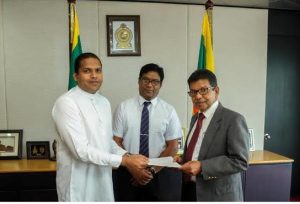Minister of Tourism Harin Fernando appointed Priantha Fernando as the Chairman of the Sri Lanka Tourism Development Authority (SLTB). Priantha Fernando is a professional with many years of experience. He qualified for an M.Sc. in tourism at the University of Surrey. Also, he gained experience in Hotel Management and Tourism at Belair College, UK.

Priantha Fernando held a number of senior positions in the public and private sector. When his appointment as the Chairman of the SLBT was announced, he was in Bangladesh on a significant project of the Bangladesh Tourism Board, which the IPE Global of India funded.
After becoming Chairman of the SLBT, Priantha Fernando appeared in the ‘Big Focus’ programme on Derana TV with Janaka Gajaba, Chairman, Sri Lanka Tourism Promotions Bureau. They were on the ball and announced around 4,000 tourist arrivals in Sri Lanka up to June 17, 2022.
Indian tourists topped the influxes, while Russian and US and UK came correspondingly next. Priantha Fernando disclosed ‘that on January 22, 2022, the number of tourist arrivals in the country were 82,300, February 96,500’. However, after April 9, the tourist industry was affected; in April, 62,000 and in May, 30,000 respectively. The ‘Aeroflot plane dispute’ affected Sri Lanka’s second highest market. The country receives just under 400,000 tourists yearly, at present, compared with 2.1 million in 2018. Today, there is a marked reduction to between 10,000 -12,000 a day.
Requirement
What is required to increase tourist input depends on the quality of the product Sri Lanka can offer to tourists. If Sri Lanka fails to deliver, she has to face long-term consequences. The areas that affect the tourists are primarily being stranded on the road due to non-availability petrol, diesel or gas for hotels.
In short, it affects the whole country. Suppose tourists in Sri Lanka who enjoy themselves are able convince others in their countries that ‘Sri Lanka is a beautiful country with hospitable people.’ It goes a long way than an advertisement in a magazine or tour operator’s recommendation.
The SLTB Chairman said in order to woo more tourists to Sri Lanka it needs the dedication and enthusiasm of everyone. The peak periods are from December to January. There is a build-up in February and March, and the off-season follows next. The country needs to improve its overall facilities; failing to do so, could lead to long-term consequences for Sri Lanka. For instance, like in the present state of affairs, the results will be terrible if tourists get stranded and face problems like due to the petrol shortages. Suppose a tourist who enjoys his stay can convey a positive message to the international community through social media, rather than adverse reports by the press (global and local), it will undoubtedly help with more tourist arrivals. Usually, the ‘repeat’ type of visitors is the majority. Indeed, word of mouth can increase the overall tourist arrivals. With Sri Lanka’s comprehensive strategies in marketing, it is possible to convey a positive message instead of being negative. Nevertheless, a tourist experience in Sri Lanka can convince his friends abroad immensely. Such messages should go a long to help the expected targets by the SLTB.
A question was submitted during the programme on the airport, immigration and emigration and other governmental institutions’ willingness to cooperate? The anchor man questioned: ‘If you are discussing the soothing of peoples’ hearts, what have you got in mind? The answer was that they have already had discussions with such institutions with the Minister and received a positive response from those institutions.
Chairman Fernando took over from there and continued that the SLBT concentrated on short-term, medium-term and long-term programmes. “Our short-term schedule is concentrated on March 2023 only. We focus on bringing about 800,000 tourists by the end of this year. It is not easy, but we can overcome many hurdles to achieve that target. If we can bring 800,000 tourists this year, we are thinking of the country’s US$ 800 million in foreign exchange earnings. Every tourist’s average stay is about 9.5 days. Our accommodation sector comprises star hotels, boutiques and guest houses, which have 47,000 rooms. We could expect an average income of 17%-18% occupancy. It is not enough to overcome the hotel industry’s deficit and needs about 38% – 40% to break even,” Chairman Fernando emphasised.
At the same time, there should be a beginning to get out of the present mess. If we bring 800,000 tourists this year, yet, there will be a one billion shortfall within the industry.
A question arose during the TV programme concerning the visa tourists get for a one-month. The Chairman of Sri Lanka Tourism Promotions Bureau said they had discussions with President and the Prime Minister separately about this problem. They await a response still as they assumed new positions only ten days ago. This question was highly valid because Indian tourists, particularly the Eastern Europeans would like to stay in Sri Lanka for more than a month. “If we can give them an extended visa, it certainly will benefit the industry and the country as well.”
Mentioning the short-term policy on ‘Ramayana Trail,’ he said the tourists are cultural valuers (out of mature from tourists from India). The Chairman of Sri Lanka Tourism Promotions Bureau spelt how they have progressed with the Indian youth. They plan to do a reality show by bringing 20 teams from India and connecting with an Indian TV channel to do a reality show. His idea was to invite Indian bloggers to encourage them to get many youth as tourists to Sri Lanka on a short-term programme. There is the Asia Cup, where 8 Asian countries participate, and the SLTB has also earmarked the Asia Cup.
Chairman Fernando then said the SLTB needs to identify the segments of the markets. It always depends on the supply and demand of a product. Some tourists like to lie on the Beach. Others may visit historical places like Sigiriya. Some visitors may want to see archaeological sites such as ruins of old kings’ palaces in Anuradhapura and Polonnaruwa, the rest will want to see wildlife. We need to identify the markets. We place such demands and upgrade our schedules. Addressing the host, the Chairman said, “as you know, there aren’t facilities even for local visitors apart from foreign tourists. At least there are no clean toilet facilities and no place to purchase a bottle of water. It is in a hellish unorganised state. We need to concentrate on what tourists take to their country. It is our responsibility to organise the industry as well as our product.
The question was raised about the ‘Ramayana Trail’ mentioning that 52 sites and displays are not yet properly done due to internal politics and politicians’ demand of an ‘Indian influence.’ In such an environment, the host of the Big Focus programme wanted to know whether the present team had a clean sheet on this.
Priantha Fernando said, “we need to change the mindset of our staff as well. If we can earn US$ 2.5 billion in 2025, it means that we will be able to be in the second place as income earners to the country, but our idea is to make the tourist industry the top earner in Sri Lanka”. The Tourism industry was in third place in Sri Lanka. The apparel industry and foreign employment were the next.
“The value chain of tourism should spread across the entire society,” Fernando said. Forty-seven thousand rooms are there in the industry, and 2.5 direct employees and 1.5 indirect employees depend on the tourist industry. All that is required is dedication and commitment to reach targets.
Answering a question on Budget Airlines to Sri Lanka, Priantha Fernando said, “Sri Lanka has 30 airline operations. They experience fewer load factors that affect their economic viability in various sectors, and they also have to pay in dollars for airport charges. The SLTB needs to find out what the Aviation policy in Sri Lanka is, but so far, SLTB has not had a chance to meet up with the Civil Aviation authorities to discuss their policy.
The biggest problem is the moratorium because the tourist industry has Rs.480 billion in debt to Banks, and the moratorium ends shortly. To help the hoteliers, the SLTB had approached several foreign investors to buy hotel shares, which will help them solve their debt problem to a certain extent. The average occupancy rate in Sri Lanka right now is approximately 30%.
Other Areas in the Pipeline
The Nallur Festival is a popular event that millions from the East and Jaffna attend. The SLTB plans to concentrate on the diaspora during the Nallur Festival because during 1981-1991, the diaspora had different experiences during the terrorist war and was later affected by the COVID-19 pandemic. Therefore, the SLTB is preparing a festival calendar to help the diaspora and people in the East and Jaffna to help themselves.
Another tourist promotion by the SLTB is to conduct road shows in India in several states. The SLTB intends to approach the Indian Cricket Board and to persuade cricket lovers to visit Sri Lanka during international cricket tournaments. The SLTB also targets Russian tourists. Russian tourists at present have access only to a few countries. The SLTB keeps their eyes and ears open to see at what stage the Chinese market door will open.
Priantha Fernando was approached by the Loyal Orchid Hotel Group in India. They manage seventy hotels in India and want to find a 10-acre land in the Colombo area to establish a US$ 15 million project to set up banquet halls. They guarantee 75% occupancy from India. At present, Sri Lankan hotels are occupied only up to 30%.
picture credit: Daily News. pic with the Minister of Tourism (by writer)






